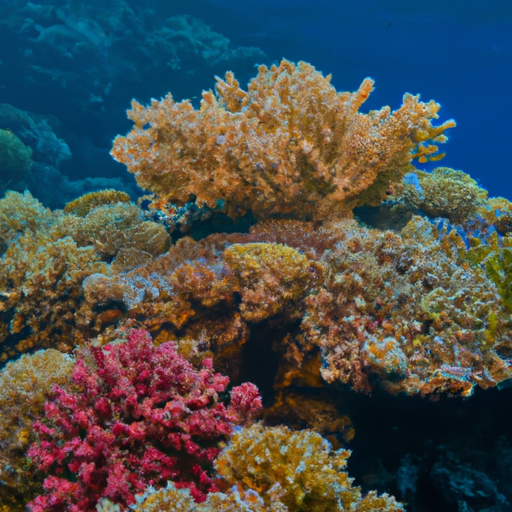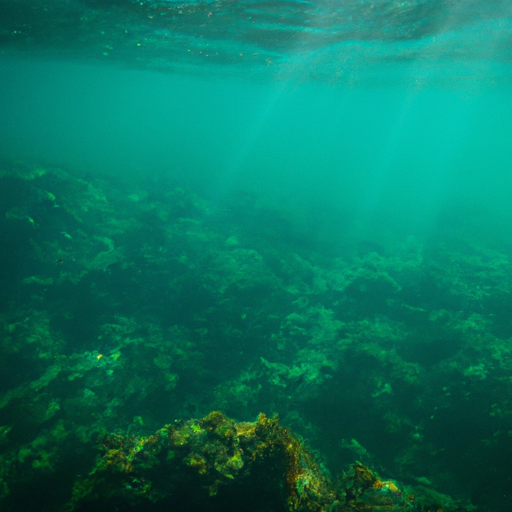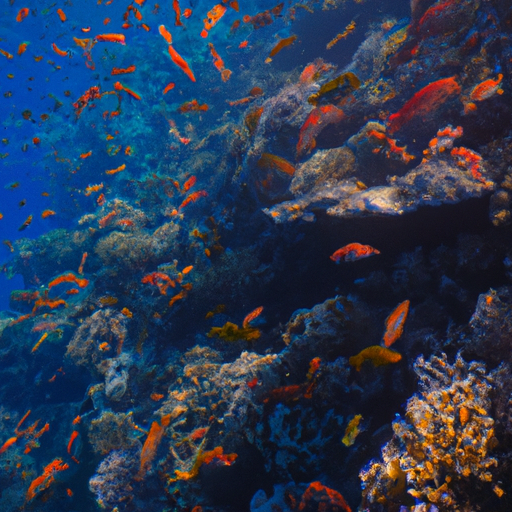
Rising Ocean Temperatures: Disrupting Marine Life
It’s no secret that rising ocean temperatures, a direct result of climate change, are having a significant impact on our planet’s marine life. The delicate balance of ocean ecosystems is being disrupted, leading to widespread consequences for marine species and the overall health of our oceans.
One of the most pressing concerns is the bleaching of coral reefs. Corals have a symbiotic relationship with tiny algae called zooxanthellae, which provide them with food and vibrant colors. However, when ocean temperatures rise, corals become stressed and expel these algae, leading to their bleaching and eventual death. Coral reefs are home to a quarter of all marine species, and their destruction would have far-reaching effects on the entire ecosystem.
Another major challenge is the altered distribution of marine species. As temperatures rise, some species are moving towards the poles in search of cooler waters, while others are becoming trapped in habitats that are no longer suitable for their survival. These changes in distribution can disrupt predator-prey relationships and competition for resources, leading to cascading effects throughout the food chain.
Marine mammals, such as whales and dolphins, are also feeling the impacts of rising ocean temperatures. Changes in water temperature can affect their prey, leading to alterations in migratory patterns and the availability of food sources. Additionally, warmer waters can promote the growth of harmful algal blooms, which produce toxins that can accumulate in the bodies of marine mammals, leading to illness and even death.
Furthermore, the acidity of the ocean is increasing as a result of climate change. This acidification poses a threat to shell-forming organisms like oysters, clams, and corals. The higher acidity levels make it difficult for these species to build and maintain their protective shells, making them more vulnerable to predation and environmental stressors.
Overall, the impact of climate change on marine life is far-reaching and poses significant challenges for the health and sustainability of ocean ecosystems. It is crucial that we take immediate action to mitigate the effects of rising ocean temperatures and reduce our carbon footprint to protect the incredible diversity of marine species and preserve the delicate balance of our oceans.
Ocean Acidification: Threatening the Balance of Marine Ecosystems
The marine ecosystems on Earth are facing challenging times due to the impact of climate change. One of the most concerning consequences of climate change is ocean acidification, which threatens the delicate balance of marine life. Ocean acidification occurs when carbon dioxide from the atmosphere is absorbed by seawater, leading to a decrease in pH levels.
The increase in carbon dioxide emissions resulting from human activities, such as burning fossil fuels and deforestation, has led to a significant rise in atmospheric carbon dioxide levels. As a result, more carbon dioxide is being absorbed by the oceans, leading to increased acidity.
The acidification of the oceans has far-reaching consequences for marine life. One of the most vulnerable organisms are coral reefs. Corals rely on a delicate symbiotic relationship with algae that provide them with food and vibrant colors. However, the increased acidity of the oceans makes it more difficult for corals to build their calcium carbonate structures, known as exoskeletons. As a result, corals become more vulnerable to bleaching and die-off, leading to the loss of entire reef ecosystems.
Furthermore, acidification affects other marine organisms such as shellfish, oysters, and plankton. These organisms rely on the availability of calcium carbonate to build their shells and skeletons. With increased acidity, it becomes harder for them to obtain the necessary building blocks, leading to weakened shells and reduced reproduction rates. This has not only direct implications for these species but also for the entire food chain, as many other marine organisms rely on them as a primary food source.
The effects of ocean acidification also extend to fish populations. Studies have shown that increased acidity can affect fish behavior, including their ability to detect predators and find food. Additionally, acidification can impact their ability to reproduce and develop properly, leading to population declines.
In conclusion, ocean acidification is a significant threat to the balance of marine ecosystems. The alarming rise in carbon dioxide emissions and subsequent absorption by the oceans has led to increased acidity levels, posing serious challenges to marine life. The destruction of coral reefs, weakened shells of shellfish, and disrupted behavior of fish are just some of the consequences of this environmental crisis. Urgent measures to reduce carbon emissions and mitigate climate change are necessary to safeguard the future of our oceans and ensure the preservation of marine ecosystems and biodiversity.
Shrinking Sea Ice: Impacts on Polar Marine Species
Climate change is having drastic effects on our planet, and one of the most vulnerable areas is the polar regions. The shrinking sea ice in the Arctic and Antarctic is causing great concern for the future of marine life in these areas. The impacts of climate change on polar marine species are far-reaching and challenging for the delicate ecosystems that exist in these environments.
One of the most significant consequences of shrinking sea ice is the loss of habitat for various species. Sea ice provides a crucial platform for many marine organisms, including polar bears, seals, and walruses. These animals rely on the ice as a hunting ground, a breeding site, and a resting place. With the decline in sea ice, these species are forced to adapt to new conditions and find alternative habitats. This disruption can lead to increased competition for resources and potential population declines.
Furthermore, the reduction in sea ice also affects the availability of food sources for marine life. Many species, such as Arctic cod and krill, depend on the ice as a nursery habitat and feeding ground. As the ice diminishes, these important food sources become less abundant, leading to potential prey shortages for species higher up the food chain, including polar bears and whales. This imbalance can have cascading effects throughout the entire ecosystem.
Another concerning impact of climate change on polar marine life is the alteration of migration patterns. Many species, including birds and marine mammals, undertake long-distance migrations to the polar regions during certain times of the year. These migrations are often timed to coincide with the presence of sea ice and the availability of food. With shrinking sea ice, the timing and extent of these migrations may be disrupted, leading to difficulties for these species in finding suitable habitats and food sources.
Additionally, the warming of polar waters due to climate change can also affect the reproductive success of many marine species. Some organisms, such as certain types of algae, depend on stable sea ice conditions for their reproductive cycles. As the ice becomes thinner and more unpredictable, the timing and duration of these cycles can be altered, potentially affecting the entire food web and the survival of species dependent on these primary producers.
The impacts of shrinking sea ice on polar marine species are complex and interconnected. The loss of habitat, changes in food availability, disruption of migration patterns, and alteration of reproductive cycles all pose significant challenges for these fragile ecosystems. As we continue to witness the effects of climate change, it is crucial to address these issues and prioritize conservation efforts to protect the unique and diverse marine life that inhabits the polar regions.
Changing Ocean Currents: Affecting Migration Patterns of Marine Animals
The Impact of Climate Change on Marine Life: Challenging Times for Ocean Ecosystems
Climate change is greatly affecting the world’s oceans, causing significant changes in ocean currents and disrupting the natural patterns of migration for marine animals. These transformations pose a significant challenge for ocean ecosystems and the delicate balance of marine life.
One of the most visible impacts of climate change on ocean ecosystems is the alteration of ocean currents. Ocean currents play a crucial role in transporting heat, nutrients, and oxygen across vast distances, shaping marine habitats and influencing the distribution of marine species. As the Earth’s climate continues to warm, the melting ice caps and increased freshwater input are altering the salinity levels of the ocean, leading to changes in the density and flow of seawater.
These changes in ocean currents have far-reaching consequences for marine life, particularly for migratory species. Many marine animals, such as whales, sea turtles, and certain fish species, rely on ocean currents as a navigation tool during their annual migrations. These animals are equipped with remarkable abilities to sense and utilize ocean currents to conserve energy and reach their intended destinations.
However, with changing ocean currents, the familiar paths and timing of migrations are becoming disrupted. Some species may encounter altered currents that delay or accelerate their journey, leading to mismatches with the availability of food or suitable breeding grounds. This can have severe implications for population stability and long-term survival.
The impact of changing ocean currents on marine animal migrations extends beyond individual species. Migration serves ecological functions such as seed dispersal, nutrient transfer, and the redistribution of energy throughout ocean ecosystems. Disruptions to these migratory patterns can have cascading effects on entire food chains and the overall health and productivity of marine ecosystems.
Furthermore, the challenges posed by climate change are not limited to changes in ocean currents. Rising sea temperatures, ocean acidification, and the loss of critical habitats like coral reefs also contribute to the predicament faced by marine life. The combined effects of these stressors put additional pressure on marine species already struggling to cope with changing migration patterns.
It is crucial to understand and monitor the impact of climate change on marine life and take steps to mitigate its effects. Conservation efforts must focus on protecting critical habitats, establishing marine protected areas, reducing greenhouse gas emissions, and promoting sustainable fishing practices. By addressing climate change and its impact on ocean ecosystems, we can ensure the long-term survival of marine species and preserve the incredible biodiversity and ecological functions of our oceans.


